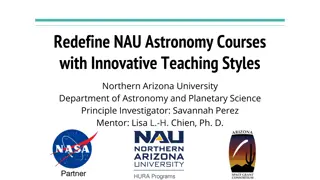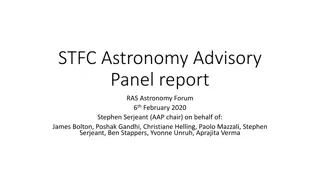Exploring Adaptive Optics Systems in Astronomy: Comparative Analysis of AO Systems for HR 8799 Planetary System
Delve into the world of adaptive optics (AO) systems through a focused investigation on imaging the HR 8799 planetary system. Compare and contrast different AO systems, discuss science goals and design choices, and analyze observational details and results. Explore which AO system is optimal for HR 8799 and how they differ in detecting various types of planets. Understand the use of different deformable mirrors (DMs) and wavefront sensors (WFSs) in AO systems. Enhance your understanding of AO technology in astronomy.
Download Presentation

Please find below an Image/Link to download the presentation.
The content on the website is provided AS IS for your information and personal use only. It may not be sold, licensed, or shared on other websites without obtaining consent from the author. Download presentation by click this link. If you encounter any issues during the download, it is possible that the publisher has removed the file from their server.
E N D
Presentation Transcript
Class Project: Focused Investigation Astro 289: Adaptive Optics February 6, 2020 Thanks to Katie Morzinski for developing this series of activities
Purpose of Starter: To introduce existing AO systems and get you thinking about science goals and design choices 1. Comparing/contrasting several different AO systems and their results when imaging the same extrasolar planetary system (HR 8799) 2. Discussion 3. Goal-driven design: iterative Science Case Performance Requirements 4. Expectations for final presentation / mini-CoDR 5. A bit about Project Management 2
HR 8799 Planetary System Science Results Observation Details HR8799 Planets imaged (b/c/d/e) SED (Temp of planets) (Yes/No) AO Special Observational Techniques Orbits/ Positions (Yes/No) Strehl ratio System System/Scie nce Camera observed FLAO/PIS CES ADI/2D star subtraction LBT H, Ks b,c,d,e No Yes 80+% Keck AO/NIRC2 Keck ADI, LOCI H, K, L b,c,d,e Yes Yes 60% ? PSF 3.8 mic, 3.1, 4.8 b,c,d only at 3.8 mic MMT MMTAO Yes Yes ?? subtractions 4
AO System Parameters AO Bench location (Cassegrain? Nasmyth?) SystemTelescope WFS Type Site/ro DM and dof Diameter Bent LBT 8.4 13 cm 627 DSM Pyramid Gregorian 249 Contin. Face Sheet Keck 10 20-25 cm S-H Nasmyth Ritchie- Chretien Seconday MMT 6.5 12 cm 336 DSM S-H 5
Here are images of the HR 8799 planetary system with these three AO systems 6
LBT H-band (1.6 microns) and 3.3 microns H band 8
MMT AO 3.3 4.8 microns 2 planets detected 3 planets detected 0 planets detected 9
Discussion about comparative AO Which AO system would you use for HR8799? What science would you be aiming at? Which AO system would you use for finding other types of planets? Why did they use different DM s? Why did they use different WFS s?
Where are we going with this? 1. Flow Chart for Goal-Driven Design 2. Defining your Performance Requirements 3. Expectations for your Project at class presentation ( mini-CoDR )
Goal-driven design: Design AO system/select AO components based on science goals Science Case Performance Requirements and Science Sky coverage PSF quality/Strehl requirement Field of view Guide star Residual wavefront error Beam size Wavefront sensor noise Time delay Fitting error G.S. magnitude bandwidth # subaps Reference Star" Wavefront Sensor Control System Deformable Mirror Optics 12 This slide based on flow charts and concepts from O. Guyon s talk on AO system design: Astronomy at 2009 CfAO AO Summer School at UCSC, R. Parenti s chapter 2 in AO Engineering Handbook ed. R. Tyson 2000, and J. Hardy chapter 9 AO for astronomical telescopes 1998.
Performance Requirements: Example (Step 1) Science Case (Step 2) Performance Requirements -- Physical Parameters (Step 3) Performance Requirements -- Observables to Measure Parameter space for search: Brown dwarf dist. 5 - 250 AU from parent star. Search space: 0.1-10 arc seconds from parent star. Minimum (and faintest) brown dwarf mass: 0.003 x Msun (L / T dwarf transition) How many brown dwarfs are orbiting stars in the Hyades cluster? Sensitivity limit: H-band magnitude~13 Contrast between planet and star: H~10 magnitudes (factor of 104) Contrast ratio between planet and star: 10-4 at close separations Notes: 1 AU = distance from earth to Sun H band is centered at a wavelength of 1.6 microns 13 Magnitude: Faintness" as viewed from Earth.
Defining Performance Requirements based on Goal Resources: Advisors Your research advisor/colleagues/professors Or I can put you in touch with an AO instrumentation expert in your field please ask White Papers for astronomy teams: Astro 2010 Decadal Survey: Science White Papers: https://baas.aas.org/community/astro2020-science-white- papers/ Project White Papers (including instruments): https://baas.aas.org/community/astro2020-apc-white-papers/ Iterate with me by email. 14
Goal-driven design: Starting with science goal vs. starting with performance requirements What if you optimize your AO system to get the best performance? Performance requirement: Get best possible contrast (dynamic range) What is the faintest planet we can image next to a bright star? Leads to: This AO system would need such a bright natural guide star to measure the wavefront that it could only observe the ~10 brightest nearby stars that exist. What if you optimize your AO system to do the best on your science goal? Science goal: Image exoplanets How frequent are Jupiter- type exoplanets seen around solar-type stars? Leads to: Observing hundreds of nearby stars and counting which ones have Jupiter- type exoplanets orbiting them. 15
Expectations for Final Project Presentations: mini-CoDR (CoDR = Conceptual Design Review)
Conceptual Design Review (CoDR) Basic science goal and performance requirements Purpose: Demonstrate feasibility of design to solve problem/answer question Describe system and sub-components but doesn t have to show they re the best design Identify areas of technical risk, for example new technologies or techniques 17
mini-CoDR Expectations 1. 2. 3. 4. 5. 6. 7. 8. 9. 10. Field of view 11. Wavefront error budget 12. Describe the main risks Instrument name Science goals Performance requirements flowing from science goals Proposed telescope/location DM (type, dof) WFS (type, sensitivity, # subapertures) Science instrument (IR imager, optical spectrograph, ) Block diagram of AO system Type and magnitude of reference star (natural, laser) 18
Bonus @ mini-CoDR 1. Acronym for your AO system/instrument 2. Logo (!) 3. Your Roles: Principle Investigator (PI), Project Scientist, Project Manager, user 4. Optical layout 5. Observing plan/how data will be gathered 6. Plan for data reduction/pipeline 7. Project timeline 8. Estimate (guess?) total project cost 19
Project Due Dates Today: Starters. Choosing AO parameters. 1. February 11th: Focused Investigation - Specific science question you want to answer with your AO systems 2. Feb 18: Performance Requirements - First draft due. Iterate with me, especially if you need more help than White Papers and local experts. 3. Second half of February: Move from performance requirements to AO design 4. 5. March 5th: Project Presentations 6. March 10th: Project Synthesis 20
FYI Project Management Overview
Project Management: Levels of Design Reviews 1. Conceptual Design Review (CoDR) a.k.a. Feasibility Design Review Preliminary Design Review (PDR) Critical Design Review (CDR) Pre-Ship Review Integration and Testing Commissioning Facility-Class Instrument 2. 3. 4. 5. 6. 7. Note: Terminology and definitions are approximate, and vary from community to community 23
Conceptual Design Review (CoDR) Basic science goal and performance requirements Purpose: Demonstrate feasibility of design to solve problem/answer question Describe system and sub-components but doesn t have to show they re the best design Identify areas of technical risk, for example new technologies or techniques 24 http://www.ing.iac.es/~docs/wht/naomi/wht-naomi-87/wht-naomi-87.html
Preliminary Design Review Detailed science goal and performance requirements Operational requirements/constraints Timeline/plan for building Details about instrument design Cost/budget Alternate choices under consideration Plan for mitigating risks 25 http://www.ing.iac.es/~docs/wht/naomi/wht-naomi-87/wht-naomi-87.html
Critical Design Review Full designs for individual components Full design for system Detailed plan for building Timelines and Gantt charts Budget review Scale models Simulations 26
Final Stages Pre-Ship Review Do subsystem components meet spec? Are they ready to ship to telescope? Integration and Testing Put all components together and run performance tests under realistic observing conditions Commissioning On-sky testing of anything that couldn t be tested in lab, and in regular observing mode Facility-class Instrument At this stage, the instrument is finished engineering and is now ready for science by the wider user community! 27


![❤[PDF]⚡ Planetary Ring Systems (Springer Praxis Books)](/thumb/21506/pdf-planetary-ring-systems-springer-praxis-books.jpg)




















